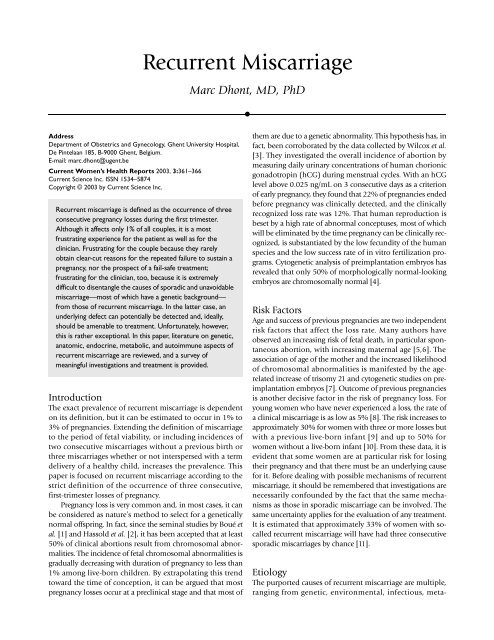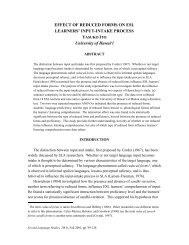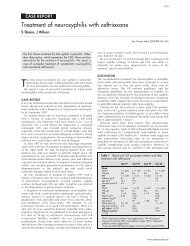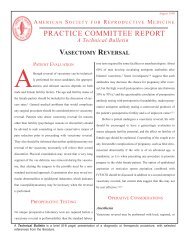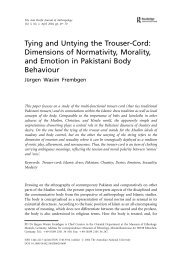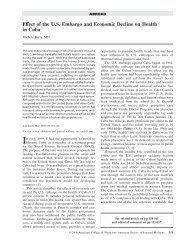Recurrent Miscarriage - University of Hawaii
Recurrent Miscarriage - University of Hawaii
Recurrent Miscarriage - University of Hawaii
Create successful ePaper yourself
Turn your PDF publications into a flip-book with our unique Google optimized e-Paper software.
<strong>Recurrent</strong> <strong>Miscarriage</strong><br />
Marc Dhont, MD, PhD<br />
Address<br />
Department <strong>of</strong> Obstetrics and Gynecology, Ghent <strong>University</strong> Hospital,<br />
De Pintelaan 185, B-9000 Ghent, Belgium.<br />
E-mail: marc.dhont@ugent.be<br />
Current Women’s Health Reports 2003, 3:361–366<br />
Current Science Inc. ISSN 1534–5874<br />
Copyright © 2003 by Current Science Inc.<br />
<strong>Recurrent</strong> miscarriage is defined as the occurrence <strong>of</strong> three<br />
consecutive pregnancy losses during the first trimester.<br />
Although it affects only 1% <strong>of</strong> all couples, it is a most<br />
frustrating experience for the patient as well as for the<br />
clinician. Frustrating for the couple because they rarely<br />
obtain clear-cut reasons for the repeated failure to sustain a<br />
pregnancy, nor the prospect <strong>of</strong> a fail-safe treatment;<br />
frustrating for the clinician, too, because it is extremely<br />
difficult to disentangle the causes <strong>of</strong> sporadic and unavoidable<br />
miscarriage—most <strong>of</strong> which have a genetic background—<br />
from those <strong>of</strong> recurrent miscarriage. In the latter case, an<br />
underlying defect can potentially be detected and, ideally,<br />
should be amenable to treatment. Unfortunately, however,<br />
this is rather exceptional. In this paper, literature on genetic,<br />
anatomic, endocrine, metabolic, and autoimmune aspects <strong>of</strong><br />
recurrent miscarriage are reviewed, and a survey <strong>of</strong><br />
meaningful investigations and treatment is provided.<br />
Introduction<br />
The exact prevalence <strong>of</strong> recurrent miscarriage is dependent<br />
on its definition, but it can be estimated to occur in 1% to<br />
3% <strong>of</strong> pregnancies. Extending the definition <strong>of</strong> miscarriage<br />
to the period <strong>of</strong> fetal viability, or including incidences <strong>of</strong><br />
two consecutive miscarriages without a previous birth or<br />
three miscarriages whether or not interspersed with a term<br />
delivery <strong>of</strong> a healthy child, increases the prevalence. This<br />
paper is focused on recurrent miscarriage according to the<br />
strict definition <strong>of</strong> the occurrence <strong>of</strong> three consecutive,<br />
first-trimester losses <strong>of</strong> pregnancy.<br />
Pregnancy loss is very common and, in most cases, it can<br />
be considered as nature’s method to select for a genetically<br />
normal <strong>of</strong>fspring. In fact, since the seminal studies by Boué et<br />
al. [1] and Hassold et al. [2], it has been accepted that at least<br />
50% <strong>of</strong> clinical abortions result from chromosomal abnormalities.<br />
The incidence <strong>of</strong> fetal chromosomal abnormalities is<br />
gradually decreasing with duration <strong>of</strong> pregnancy to less than<br />
1% among live-born children. By extrapolating this trend<br />
toward the time <strong>of</strong> conception, it can be argued that most<br />
pregnancy losses occur at a preclinical stage and that most <strong>of</strong><br />
them are due to a genetic abnormality. This hypothesis has, in<br />
fact, been corroborated by the data collected by Wilcox et al.<br />
[3]. They investigated the overall incidence <strong>of</strong> abortion by<br />
measuring daily urinary concentrations <strong>of</strong> human chorionic<br />
gonadotropin (hCG) during menstrual cycles. With an hCG<br />
level above 0.025 ng/mL on 3 consecutive days as a criterion<br />
<strong>of</strong> early pregnancy, they found that 22% <strong>of</strong> pregnancies ended<br />
before pregnancy was clinically detected, and the clinically<br />
recognized loss rate was 12%. That human reproduction is<br />
beset by a high rate <strong>of</strong> abnormal conceptuses, most <strong>of</strong> which<br />
will be eliminated by the time pregnancy can be clinically recognized,<br />
is substantiated by the low fecundity <strong>of</strong> the human<br />
species and the low success rate <strong>of</strong> in vitro fertilization programs.<br />
Cytogenetic analysis <strong>of</strong> preimplantation embryos has<br />
revealed that only 50% <strong>of</strong> morphologically normal-looking<br />
embryos are chromosomally normal [4].<br />
Risk Factors<br />
Age and success <strong>of</strong> previous pregnancies are two independent<br />
risk factors that affect the loss rate. Many authors have<br />
observed an increasing risk <strong>of</strong> fetal death, in particular spontaneous<br />
abortion, with increasing maternal age [5,6]. The<br />
association <strong>of</strong> age <strong>of</strong> the mother and the increased likelihood<br />
<strong>of</strong> chromosomal abnormalities is manifested by the agerelated<br />
increase <strong>of</strong> trisomy 21 and cytogenetic studies on preimplantation<br />
embryos [7]. Outcome <strong>of</strong> previous pregnancies<br />
is another decisive factor in the risk <strong>of</strong> pregnancy loss. For<br />
young women who have never experienced a loss, the rate <strong>of</strong><br />
a clinical miscarriage is as low as 5% [8]. The risk increases to<br />
approximately 30% for women with three or more losses but<br />
with a previous live-born infant [9] and up to 50% for<br />
women without a live-born infant [10]. From these data, it is<br />
evident that some women are at particular risk for losing<br />
their pregnancy and that there must be an underlying cause<br />
for it. Before dealing with possible mechanisms <strong>of</strong> recurrent<br />
miscarriage, it should be remembered that investigations are<br />
necessarily confounded by the fact that the same mechanisms<br />
as those in sporadic miscarriage can be involved. The<br />
same uncertainty applies for the evaluation <strong>of</strong> any treatment.<br />
It is estimated that approximately 33% <strong>of</strong> women with socalled<br />
recurrent miscarriage will have had three consecutive<br />
sporadic miscarriages by chance [11].<br />
Etiology<br />
The purported causes <strong>of</strong> recurrent miscarriage are multiple,<br />
ranging from genetic, environmental, infectious, meta-
362 Reproductive Endocrinology and Fertility<br />
bolic, and endocrine to purely anatomic ones. The best<br />
defined causes are parental chromosomal abnormalities,<br />
metabolic abnormalities, and anatomic abnormalities.<br />
Genetic factors<br />
<strong>Recurrent</strong> aneuploidy<br />
The major cause <strong>of</strong> clinically recognized abortions is genetic.<br />
In order <strong>of</strong> frequency, the main chromosomal abnormalities<br />
are autosomal trisomies, polyploidy, and monosomy X. Most<br />
trisomies show a maternal age effect, with chromosomes 16<br />
and 22 most commonly involved. Triploidy and tetraploidy<br />
account for 30% <strong>of</strong> chromosomally abnormal spontaneous<br />
abortions. Triploid fetuses are usually 69,XXY or 69,XXX and<br />
result from dispermic fertilization. Some triploid conceptuses<br />
present as a partial mole, characterized by a large gestational<br />
sac and cystic degeneration <strong>of</strong> the placenta. Tetraploidy rarely<br />
progresses beyond 4 or 5 weeks <strong>of</strong> gestation. Monosomy X is<br />
the single most common chromosomal abnormality among<br />
spontaneous abortions, accounting for 15% to 20% <strong>of</strong> all<br />
abortions. Chromosomal abnormalities are less likely to<br />
occur in spontaneous abortions for women younger than age<br />
36 with a history <strong>of</strong> recurrent abortion [12]. Numeric chromosomal<br />
abnormalities, however, might be involved in both<br />
recurrent and sporadic losses.<br />
Couples who are predisposed toward chromosomal<br />
abnormal conceptions will also be at increased risk for<br />
aneuploid live-born infants. In fact, women with a previous<br />
trisomy 18 or 21 pregnancy have an increased risk for a subsequent<br />
affected fetus [13]. Data from preimplantation<br />
embryos support the concept <strong>of</strong> recurrent aneuploidy in<br />
women with recurrent abortion [14].<br />
Structural chromosomal abnormalities<br />
Chromosomal translocation is the most common structural<br />
rearrangement involved in recurrent miscarriage. Cytogenetic<br />
screening <strong>of</strong> couples with recurrent abortion reveals that the<br />
prevalence <strong>of</strong> translocation in either parent is 3% to 5%, with<br />
the wife being affected twice as frequently as the husband<br />
[11]. Pregnancy loss and fetal abnormalities depend on the<br />
size, location, and type <strong>of</strong> structural rearrangement.<br />
Mendelian and polygenic factors<br />
Single-gene or polygenic factors, involved in fundamental<br />
cellular and reproductive processes, are rarely detected,<br />
but could be causing recurrent euploid losses. Skewed X<br />
inactivation, defined as 90% inactivation <strong>of</strong> one specific<br />
parental allele, has also been found more frequently in<br />
women with recurrent abortion [15•]. This is only one<br />
example <strong>of</strong> how mutant genes could be involved in repetitive<br />
losses <strong>of</strong> pregnancy.<br />
Uterine abnormalities<br />
There is no doubt that uterine defects can predispose women<br />
to reproductive difficulties, including first- and second-trimester<br />
pregnancy losses, preterm labor and birth, and abnormal<br />
fetal presentation. These anatomic abnormalities can be<br />
congenital, including diethylstilbestrol-related abnormalities,<br />
or acquired, such as intrauterine adhesions or leiomyomata.<br />
In women with three or more consecutive<br />
spontaneous abortions who have undergone hysterosalpingography<br />
or hysteroscopic examination <strong>of</strong> their uteri, müllerian<br />
anomalies have been found in 8% to 10%. Women with<br />
müllerian anomalies might be predisposed to recurrent pregnancy<br />
loss because <strong>of</strong> inadequate vascularity to the developing<br />
embryo and placenta, reduced intraluminal volume, or<br />
cervical incompetence. <strong>Recurrent</strong> pregnancy losses resulting<br />
from a uterine septum, bicornuate uterus, intrauterine adhesions,<br />
and fibroids mainly occur in the second trimester <strong>of</strong><br />
pregnancy. There is little evidence that surgical correction <strong>of</strong><br />
uterine abnormalities is <strong>of</strong> any benefit in preventing recurrent<br />
first-trimester abortion.<br />
Antiphospholipid antibody syndrome<br />
The antiphospholipid antibody syndrome is a broad and<br />
heterogeneous entity encompassing patients with specific<br />
antibodies to both lupus anticoagulant and anticardiolipin,<br />
as well as nonspecific antinuclear antibodies. An<br />
association between second- and third-trimester pregnancy<br />
complications and fetal loss is well established. More controversial<br />
is the role <strong>of</strong> this syndrome in first-trimester<br />
losses. Many studies have found an increased prevalence <strong>of</strong><br />
the antiphospholipid antibody syndrome, ranging from<br />
7% to 25% in patients with recurrent, spontaneous abortion.<br />
Although a causal relationship between the antiphospholipid<br />
antibody syndrome and recurrent abortion is not<br />
yet firmly established, several therapeutic trials with low<br />
doses <strong>of</strong> aspirin, heparin, and corticosteroids have been<br />
conducted. The effects <strong>of</strong> these interventions were recently<br />
reviewed [16•]. The conclusion from 10 trials (n = 627)<br />
that fulfilled the inclusion criteria was that a combination<br />
therapy with aspirin and heparin might reduce pregnancy<br />
loss in women with antiphospholipid antibodies by 54%.<br />
The authors, however, wisely add that further large, randomized<br />
controlled trials with adequate allocation concealment<br />
are still necessary.<br />
Hereditary thrombophilia<br />
Although maternal hypercoagulability is undoubtedly a risk<br />
factor in successful reproduction, its role in first-trimester<br />
abortion is controversial. An association between recurrent<br />
abortion and factor V Leiden, prothrombin G20210A mutation,<br />
MTHFR C677T mutation, and other hereditary thrombophilias<br />
has been either supported or refuted in numerous<br />
studies. Because there is no evidence that antithrombotic therapy<br />
effectively prevents abortion, the American College <strong>of</strong><br />
Obstetricians and Gynecologists’ ACOG Practice Bulletin from<br />
2001 does not recommend testing for heritable thrombophilias<br />
in women with recurrent abortion [17].
<strong>Recurrent</strong> <strong>Miscarriage</strong> • Dhont 363<br />
Immunologic abnormalities<br />
Alloimmune aspects<br />
For several decades it has been speculated that a defect in the<br />
maternal immune response to the semiallogeneic fetal graft<br />
could be involved in the mechanism <strong>of</strong> recurrent abortion. In<br />
fact, because the fetus is a semiallograft, some protective<br />
immunologic mechanisms should be involved to prevent<br />
maternal rejection. Paradoxically, opposing parental histocompatibility<br />
seems to be necessary for maintaining pregnancy<br />
by induction <strong>of</strong> protective blocking antibodies. This<br />
hypothesis makes sense from a teleologic and evolutionary<br />
point <strong>of</strong> view, because it would guarantee reproductive heterogeneity.<br />
Initially, studies showed greater parental sharing in<br />
aborters than in controls. Based on this observation, immunization<br />
<strong>of</strong> recurrent aborters with paternal or third-party<br />
leukocytes prior to a next pregnancy or repeated boluses <strong>of</strong><br />
gamma globulins starting before or early in pregnancy have<br />
been tried. Although a beneficial effect was observed in some<br />
trials, a recent prospective randomized trial involving 183<br />
women with three or more spontaneous abortions failed to<br />
show any beneficial effect <strong>of</strong> immunization [18•]. These negative<br />
results do not completely negate the role <strong>of</strong> parental<br />
human leukocyte antigen (HLA)-sharing in the mechanism<br />
<strong>of</strong> abortion in a subset <strong>of</strong> repetitive aborters. Two recent studies<br />
have shown that the sharing <strong>of</strong> certain HLA-G alleles by<br />
both partners was significantly associated with an increased<br />
risk for miscarriage [19•,20]. HLA-G and HLA-E are expressed<br />
on invasive trophoblast cells. This expression pattern is<br />
unique among HLA genes and suggests that HLA-G might be<br />
involved in interactions that are critical in establishing or<br />
maintaining pregnancy.<br />
Although some studies have shown a beneficial effect<br />
<strong>of</strong> intravenous immune globulin in recurrent aborters,<br />
there is, as yet, no convincing evidence to support the systematic<br />
use <strong>of</strong> this treatment in the management <strong>of</strong> recurrent<br />
miscarriage [21•].<br />
Antifetal and other antibodies<br />
Maternal embryotoxic antibodies, induced by fetal or paternal<br />
antigens, could interfere with fetal survival. A classic<br />
example is the late pregnancy loss caused by anti-D antibodies<br />
in Rhesus-negative women. A rare cause <strong>of</strong> recurrent<br />
abortion is the presence <strong>of</strong> anti-P antibodies in mothers<br />
with the P blood group. Successful treatment <strong>of</strong> repeated<br />
pregnancy loss due to blood group P incompatibility by<br />
plasmapheresis has been reported.<br />
Several studies have shown an increased frequency <strong>of</strong><br />
antisperm antibodies among women experiencing repeated<br />
abortions. Pregnancy could be endangered by cross-reaction<br />
with paternally derived antigens, which might be essential for<br />
embryonic survival. In a large, prospective study, however,<br />
Simpson et al. [22] found no difference in the incidence <strong>of</strong><br />
antisperm antibodies in women who experienced pregnancy<br />
loss and controls.<br />
Endocrine and metabolic disorders<br />
Diabetes, hypothyroidism, polycystic ovary syndrome<br />
(PCOS), luteal phase defect, and obesity are classically<br />
associated with an increased risk <strong>of</strong> miscarriage.<br />
To address the effect <strong>of</strong> diabetes on the risk <strong>of</strong> spontaneous<br />
abortion, Mills et al. [23] enrolled 386 women with<br />
insulin-dependent diabetes and 432 women without diabetes<br />
before or within 21 days after conception and followed<br />
both groups prospectively. Incidence <strong>of</strong> pregnancy<br />
loss was the same in both groups (16.1% and 16.2%).<br />
Nonetheless, the diabetic women who had spontaneous<br />
abortions had higher fasting and postprandial glucose levels<br />
in the first trimester than those whose pregnancies continued<br />
to delivery.<br />
Thyroid hormones used to be an empirical treatment<br />
for recurrent abortion, but clear evidence <strong>of</strong> an association<br />
between thyroid function and pregnancy wastage has never<br />
been provided. Antithyroid antibodies, however, are markers<br />
for an increased risk for abortion [11].<br />
Although luteal phase defects have long been a paradigm<br />
<strong>of</strong> an endocrine cause <strong>of</strong> infertility and early pregnancy<br />
wastage, the definition, diagnosis, and, hence, the<br />
relation to infertility in general are still very confusing. Initially,<br />
a distinction was made between a short luteal phase<br />
and a deficient luteal phase. Particularly the latter was<br />
deemed to be associated with early pregnancy wastage. In<br />
principle, a deficient luteal phase can be diagnosed either<br />
by a timed endometrium biopsy or by one or more progesterone<br />
determinations in the luteal phase. The diagnostic<br />
criteria are, however, moot, and, moreover, owing to biologic<br />
cycle variations, it is extremely difficult to ascertain<br />
whether a deficient corpus luteum function will also occur<br />
in the actual cycle <strong>of</strong> conception. There is no solid evidence<br />
for a beneficial effect <strong>of</strong> supplementation <strong>of</strong> the luteal<br />
phase with either progesterone or hCG. This is not surprising,<br />
because the origin <strong>of</strong> luteal-phase deficiency could as<br />
well originate in the preceding follicular phase, making the<br />
endometrium unresponsive to an extraprogestational or a<br />
luteotrophic stimulus.<br />
Both elevated luteinizing hormone (LH) levels and PCOS<br />
are associated with an increased incidence <strong>of</strong> abortion<br />
[24,25]. By inducing premature oocyte maturation and<br />
luteinization, high tonic serum concentrations <strong>of</strong> LH could<br />
have a deleterious effect on oocyte and embryo quality, and<br />
perhaps the endometrium. Gonadotropin-releasing hormone<br />
analog (GnRHa) used prior to human menopausal gonadotropin<br />
(hMG) administration might, therefore, improve the<br />
outcome <strong>of</strong> ovulation induction. The Cochrane Subfertility<br />
Review Group, after analyzing all randomized, controlled trials,<br />
concluded that there was no sufficient evidence that the<br />
combined use <strong>of</strong> GnRHa and hMG would increase the livebirth<br />
rate in these incidences [26]. More recent data refute the<br />
association between elevated LH levels or PCOS with the outcome<br />
<strong>of</strong> pregnancy [27,28]. Differences in diagnostic criteria
364 Reproductive Endocrinology and Fertility<br />
for PCOS and patient-selection bias could be at the origin <strong>of</strong><br />
these conflicting opinions. More recently, the focus has been<br />
shifted to insulin resistance as a possible explanation for the<br />
increased incidence <strong>of</strong> abortion in patients with PCOS and/or<br />
obesity. Wang et al. [29] found a positive relationship<br />
between body mass index and the risk <strong>of</strong> spontaneous abortion<br />
in 2349 women who became pregnant after assisted<br />
reproductive technology treatment. The prevalence <strong>of</strong> insulin<br />
resistance, determined by elevated fasting insulin levels, was<br />
higher in women (n = 74) with recurrent abortion (27%)<br />
compared with controls (9.5%) [30•]. In two small, retrospective<br />
studies, metformin, an insulin sensitizer, was found<br />
to decrease the risk <strong>of</strong> spontaneous abortion [31,32].<br />
Lifestyle and environmental factors<br />
This is a very sensitive but also complicated issue. Couples<br />
experiencing recurrent pregnancy loss are <strong>of</strong>ten concerned<br />
that toxins within the environment contributed to their<br />
reproductive difficulty, but hard evidence on the impact <strong>of</strong><br />
potential environmental toxins and other teratogens is not<br />
readily available. Heavy metals (such as lead and mercury),<br />
organic solvents, alcohol, and ionizing radiation are confirmed<br />
environmental teratogens, and exposure could contribute<br />
to pregnancy loss. Caffeine, cigarette smoking, and<br />
hyperthermia are suspected teratogens, and the teratogenic<br />
impact <strong>of</strong> pesticides remains unknown. As is everybody,<br />
pregnant women are exposed to many exogenous agents,<br />
some <strong>of</strong> which have been associated with the risk <strong>of</strong> fetal<br />
loss. Due to many confounding factors and recall bias, all<br />
case-controlled studies on this topic are susceptible to uncertainty.<br />
For repetitive losses to occur, some chronic exposure<br />
to toxic agents should be assumed. Consumption <strong>of</strong> five or<br />
more units <strong>of</strong> alcohol per week and 375 mg or more caffeine<br />
per day during pregnancy were found to increase the risk <strong>of</strong><br />
spontaneous abortion [33,34], but some authors doubt the<br />
validity <strong>of</strong> most studies on caffeine intake and the risk <strong>of</strong><br />
abortion [35]. An association between smoking and spontaneous<br />
abortion is accepted, but its effect presumably is small<br />
and could be totally explained by confounding factors.<br />
Diagnosis and Management<br />
Evaluation<br />
According to the definition <strong>of</strong> recurrent abortion, investigation<br />
should only start after three losses. Indeed, most <strong>of</strong> the<br />
time, spontaneous abortion is a random event and represents<br />
the natural selection process, but the odds <strong>of</strong> losing a next<br />
pregnancy increases with each previous spontaneous abortion<br />
[36]. Additionally, the patient will insist on explanation<br />
for the previous loss, prognosis for the next pregnancy, and,<br />
most importantly, advice with regard to prevention. Clinical<br />
care <strong>of</strong> patients who have had one or more abortions should,<br />
therefore, be graduated, starting from the first abortion, with<br />
a careful history, physical and gynecologic examinations, and<br />
investigation <strong>of</strong> uterine and endocrine factors, particularly<br />
insulin resistance. After two or three losses, lupus anticoagulant<br />
and anticardiolipin antibody should be determined,<br />
and a karyotyping from both parents should be obtained.<br />
Because there is no evidence that antithrombotic therapy<br />
prevents abortion, the expensive testing for thrombophilia<br />
factors cannot be recommended.<br />
Treatment<br />
Given the good outcome for most couples with unexplained<br />
recurrent abortion in the absence <strong>of</strong> treatment, it is difficult to<br />
recommend unproven therapies, especially if they are invasive<br />
and expensive. Explanation and the appropriate emotional<br />
support are the first and perhaps two most important ingredients<br />
<strong>of</strong> therapy. In fact, antenatal counseling and psychological<br />
support in pregnancy for couples with recurrent abortion<br />
and no abnormal findings resulted in a pregnancy success rate<br />
<strong>of</strong> 86%, compared with a success rate <strong>of</strong> 33% observed in<br />
women who were given no specific antenatal care [37].<br />
Metabolic factors<br />
Because there is strong evidence that obesity and/or insulin<br />
resistance are associated with an increased risk <strong>of</strong> miscarriage,<br />
weight reduction in obese women is a first step in<br />
the treatment. Metformin seems to improve pregnancy<br />
outcome, but this treatment cannot yet be recommended<br />
because the evidence is limited to a few cohort studies,<br />
and the safety <strong>of</strong> metformin in the first trimester <strong>of</strong> pregnancy<br />
is not yet established.<br />
Environmental factors<br />
Although the effect <strong>of</strong> environmental factors on the risk <strong>of</strong><br />
abortion is not uniformly convincing, it makes sense to<br />
strongly recommend a healthy lifestyle, and give explicit<br />
advice concerning caffeine (from none to a maximum <strong>of</strong><br />
two cups <strong>of</strong> caffeine-containing beverage a day) and alcohol<br />
(preferably none, to a maximum <strong>of</strong> one unit a day) consumption.<br />
This is also an ideal time to motivate the patient<br />
to completely abandon smoking. The only medication that<br />
can be advised to all women intending to get pregnant is<br />
folic acid, with no pretense that this will prevent a subsequent<br />
miscarriage.<br />
Uterine malformations<br />
There are no randomized trials to prove the value <strong>of</strong> surgical<br />
correction <strong>of</strong> uterine malformations for the prevention <strong>of</strong><br />
first-trimester, recurrent abortion, but common sense and<br />
observational studies allow the formulation <strong>of</strong> advice.<br />
Because hysteroscopic resection <strong>of</strong> a uterine septum is a simple<br />
procedure, it can be recommended for all patients, even<br />
for those without a history <strong>of</strong> recurrent abortion. The same<br />
applies to the hysteroscopic lysis <strong>of</strong> intrauterine adhesions<br />
and the hysteroscopic removal <strong>of</strong> endometrial polyps and<br />
submucous myomata. More caution should be exerted in case<br />
<strong>of</strong> intramural myomata. If large myomata that distort the<br />
uterine cavity are the only abnormality found in a woman<br />
with recurrent abortion, a myomectomy can be justified. Unification<br />
procedures in cases <strong>of</strong> uterus didelphia or bicornuate
<strong>Recurrent</strong> <strong>Miscarriage</strong> • Dhont 365<br />
uterus are pointless, particularly when the reproductive failure<br />
is limited to the first trimester <strong>of</strong> pregnancy.<br />
Autoimmune factors<br />
Two studies have shown that treatment with aspirin (75 mg/<br />
d) and heparin (5000 U sc bid) result in a higher live-birth<br />
rate (71%–80%) than treatment with aspirin alone (42%–<br />
44%) [38,39]. In a recent trial, aspirin alone was found to be<br />
as effective as the combined treatment with heparin [40•].<br />
Genetic factors<br />
Oocyte or sperm donation is the only etiologic treatment<br />
when a recurrent genetic factor is involved. A recent development<br />
is preimplantation genetic diagnosis (PGD) for aneuploidy<br />
and translocations [41]. Several studies have shown<br />
that the incidence <strong>of</strong> abortion can be reduced by aneuploidy<br />
screening. Whether a sizeable proportion <strong>of</strong> women with<br />
recurrent abortion will ultimately benefit from this invasive<br />
and expensive treatment remains as yet unanswered.<br />
Conclusions<br />
Recently, the spectrum <strong>of</strong> etiologies for recurrent miscarriage<br />
has been changing. Some causes, such as luteal insufficiency<br />
and infectious diseases, have lost much <strong>of</strong> their previous<br />
importance, but some new, exciting findings have enriched<br />
our understanding <strong>of</strong> possible mechanisms <strong>of</strong> recurrent pregnancy<br />
loss. The sharing <strong>of</strong> parental antigens has become a hot<br />
topic again with the finding <strong>of</strong> specific HLA alleles that seem<br />
to be associated with recurrent miscarriage. Although genetic<br />
abnormalities have been implicated in recurrent loss <strong>of</strong> pregnancy<br />
for some time, skewed X-inactivation was recently<br />
found to be an additional genetic factor.<br />
As in many other areas <strong>of</strong> medicine, however, increased<br />
knowledge <strong>of</strong> physiopathology does not necessarily lead to<br />
advances in treatment. There are several interesting therapeutic<br />
issues that remain to be fully explored by randomized<br />
trials. The role <strong>of</strong> low-dose aspirin, whether or not associated<br />
with heparin, requires further confirmation. The safety and<br />
efficacy <strong>of</strong> metformin in the treatment <strong>of</strong> insulin resistance in<br />
the first trimester <strong>of</strong> pregnancy remains to be established, and<br />
the place <strong>of</strong> preimplantation genetic screening is yet to be<br />
determined. In spite <strong>of</strong> all efforts, however, we will be confronted<br />
for many years to come with some inherent defects <strong>of</strong><br />
human reproduction that are not amenable to treatment.<br />
References and Recommended Reading<br />
Papers <strong>of</strong> particular interest, published recently, have been<br />
highlighted as:<br />
• Of importance<br />
•• Of major importance<br />
1. Boué J, Boué A, Lazar P: Retrospective and prospective<br />
epidemiological studies <strong>of</strong> 1500 karyotyped spontaneous<br />
human abortions. Teratology 1975, 12:11–26.<br />
2. Hassold T, Chen N, Funkhauser J, et al.: A cytogenetic study <strong>of</strong><br />
1000 spontaneous abortions. Ann Hum Genet 1980, 44:151–164.<br />
3. Wilcox AJ, Weinberg CR, O’Conner JF, et al.: Incidence <strong>of</strong> early<br />
loss <strong>of</strong> pregnancy. N Engl J Med 1988, 319:189–194.<br />
4. Delhanty JD, Harper JC, Ao A, et al.: Multicolour FISH detects<br />
frequent chromosomal mosaicism and chaotic division in<br />
normal preimplantation embryos from fertile patients. Hum<br />
Genet 1997, 99:755–760.<br />
5. Abdella HI, Burton G, Kirkland A, et al.: Age, pregnancy and<br />
miscarriage: uterine versus ovarian factors. Hum Reprod 1993,<br />
8:1512–1517.<br />
6. Andersen N, Wohlfahrt J, Christens P, et al.: Maternal age and<br />
fetal loss: population based register linkage study. Br Med J<br />
2000, 320:1708–1712.<br />
7. Munné S, Alikani M, Tomkin G, et al.: Embryo morphology,<br />
developmental rates and maternal age are correlated with<br />
chromosome abnormalities. Fertil Steril 1995, 64:382–391.<br />
8. Regan L, Braude PR, Trembath PL: Influence <strong>of</strong> postreproductive<br />
performance on risk <strong>of</strong> spontaneous abortion. Br Med J 1989,<br />
299:541–545.<br />
9. Warburton D, Fraser FC: Spontaneous abortion risk in man: data<br />
from reproductive histories collected in a medical genetics unit.<br />
Am J Hum Genet 1964, 16:1–25.<br />
10. Poland BJ, Miller JR, Jones DC, Trimble BK: Reproductive<br />
counselling in patients who had a spontaneous abortion. Am<br />
J Obstet Gynecol 1977, 127:685–691.<br />
11. Stenchever MA, Droegemueller W, Herbst AL, Mishell DR:<br />
Spontaneous and recurrent abortion. In Comprehensive<br />
Gynecology, edn 4. St. Louis: Mosby; 2001:280–299.<br />
12. Stephenson MD, Awartani KA, Robinson WP: Cytogenetic<br />
analysis <strong>of</strong> miscarriages from couples with recurrent miscarriage:<br />
a case controlled study. Hum Reprod 2002, 17:446–451.<br />
13. Snijders RJ, Sundberg K, Holzgreve W, et al.: Maternal age and<br />
gestation-specific risk for trisomy 21: effect <strong>of</strong> previous affected<br />
pregnancy. Ultrasound Obstet Gynecol 1999, 13:167–170.<br />
14. Rubio C, Vidal F, Minguéz Y, et al.: High incidence <strong>of</strong><br />
chromosomal abnormalities in preimplantation embryos<br />
from recurrent spontaneous abortion patients. Hum Reprod<br />
2000, 15:81–82.<br />
15.• Lanasa MC, Hogge WA, Kubik CJ, et al.: A novel X<br />
chromosome-linked genetic cause <strong>of</strong> recurrent spontaneous<br />
abortion. Am J Obstet Gynecol 2001, 185:563–568.<br />
The authors tested the hypothesis that a subset <strong>of</strong> women with<br />
recurrent spontaneous abortion are carriers <strong>of</strong> X-linked recessive<br />
disorders that result in the loss <strong>of</strong> male pregnancies by comparing X<br />
chromosome inactivation patterns in 105 female patients with<br />
idiopathic recurrent pregnancy loss and 101 women (control subjects)<br />
with a single successful pregnancy and no history <strong>of</strong> pregnancy loss.<br />
Fourteen percent <strong>of</strong> women with unexplained recurrent pregnancy loss<br />
had highly skewed X inactivation, which suggests that they are carriers<br />
<strong>of</strong> X-linked recessive lethal traits. This was corroborated by the fact that<br />
patients with highly skewed X chromosome inactivation showed a<br />
significant decrease in male children.<br />
16.• Empson M, Lassere M, Craig JC, Scott JR: <strong>Recurrent</strong> pregnancy<br />
loss with antiphospholipid antibody: a systematic review <strong>of</strong><br />
therapeutic trials. Obstet Gynecol 2002, 99:135–144.<br />
In this paper, interventional trials to improve pregnancy outcome in<br />
women with antiphospholipid antibodies are reviewed. Pregnancy loss<br />
and adverse neonatal outcomes were the main outcome measures.<br />
Combination therapy with aspirin and heparin might reduce pregnancy<br />
loss in women with antiphospholipid antibodies, but further welldesigned<br />
studies are still necessary to prove the exact benefit.<br />
17. Management <strong>of</strong> recurrent early pregnancy loss. American College<br />
<strong>of</strong> Obstetrics and Gynecology Practice Bulletin. 2001, 24:1–17.<br />
18.• Ober C, Karrison T, Odem RR, et al.: Mononuclear-cell<br />
immunisation in prevention <strong>of</strong> recurrent miscarriages: a<br />
randomised trial. Lancet 1999, 354:365–369.<br />
In a multicenter double-blind trial, couples with unexplained<br />
recurrent miscarriage were randomized to receive either immunization<br />
with paternal mononuclear cells (n = 91) or placebo (saline) (n = 92).<br />
The success rate was not different in the treatment group versus the<br />
control group, which led the authors to conclude that immunization<br />
with paternal mononuclear cells should not be <strong>of</strong>fered as a treatment<br />
for pregnancy loss.
366 Reproductive Endocrinology and Fertility<br />
19.• Aldrich CL, Stephenson MD, Karrison T, et al.: HLA-G genotypes<br />
and pregnancy outcome in couples with unexplained recurrent<br />
miscarriage. Mol Hum Reprod 2001, 12:1167–1172.<br />
Human leukocyte antigen-G is a nonclassic HLA expressed primarily<br />
in fetal tissues at the maternal-fetal interface. This expression pattern<br />
is unique among HLA genes and suggests that HLA-G might be<br />
involved in interactions that are critical in establishing and/or<br />
maintaining pregnancy. To evaluate the role <strong>of</strong> polymorphisms at<br />
this locus, the authors investigated 113 couples with unexplained,<br />
recurrent miscarriage by genotyping for seven polymorphisms <strong>of</strong> 12<br />
HLA-G alleles. Two polymorphisms were significantly associated<br />
with an increased risk for miscarriage. The authors conclude that<br />
allelic variation in the alpha-2 domain <strong>of</strong> the HLA-G1 is<strong>of</strong>orms<br />
contributes to recurrent miscarriage.<br />
20. Pfeiffer KA, Fimmers R, Engels G, et al.: The HLA-G genotype is<br />
potentially associated with idiopathic recurrent spontaneous<br />
abortion. Mol Hum Reprod 2001, 7:373–378.<br />
21.• Branch DW, Porter TF, Paidas MJ, et al.: Obstetric uses <strong>of</strong><br />
intravenous immunoglobulin: successes, failures, and<br />
promises. J Allergy Clin Immunol 2001, 108:S133–S138.<br />
In this review, the use <strong>of</strong> intravenous immunoglobulins is critically<br />
analyzed. The conclusion is that, pending future convincing studies,<br />
immunoglobulin therapy cannot be recommended as an effective<br />
therapy for the management <strong>of</strong> recurrent miscarriage.<br />
22. Simpson JL, Carson SA, Mills JL, et al.: Prospective study<br />
showing that antisperm antibodies are not associated with<br />
pregnancy losses. Fertil Steril 1996, 66:36–42.<br />
23. Mills JL, Simpson JL, Driscoll SG, et al.: Incidence <strong>of</strong> spontaneous<br />
abortion among normal women and insulin-dependent<br />
diabetic women whose pregnancies were identified within 21<br />
days <strong>of</strong> conception. N Engl J Med 1988, 319:1617–1623.<br />
24. Regan L, Owen EJ, Jacobs HS: Hypersecretion <strong>of</strong> luteinising<br />
hormone, infertility, and miscarriage. Lancet 1990,<br />
336:1141–1144.<br />
25. Barnes RB: Diagnosis and therapy <strong>of</strong> hyperandrogenism.<br />
Baillieres Clin Obstet Gynaecol 1997, 11:369–396.<br />
26. Hughes E, Collins J, Vandekerckhove P: Gonadotropinreleasing<br />
hormone analogue as an adjunct to gonadotropin<br />
therapy for clomiphene-resistant polycystic ovarian<br />
syndrome. Cochrane Database Syst Rev 2000, 2:CD000097.<br />
27. Nardo LG, Rai R, Backos M, et al.: High serum luteinizing<br />
hormone and testosterone concentrations do not predict<br />
pregnancy outcome in women with recurrent miscarriage.<br />
Fertil Steril 2002, 77:348–352.<br />
28. Rai R, Backos M, Rushworth F, Regan L: Polycystic ovaries and<br />
recurrent miscarriage: a reappraisal. Hum Reprod 2000,<br />
15:612–615.<br />
29. Wang JX, Davies MJ, Norman RJ: Obesity increases the risk <strong>of</strong><br />
spontaneous abortion during infertility treatment. Obes Res<br />
2002, 10:551–554.<br />
30.• Craig LB, Ke RW, Kutteh WH: Increased prevalence <strong>of</strong> insulin<br />
resistance in women with a history <strong>of</strong> recurrent pregnancy<br />
loss. Fertil Steril 2002, 78:487–490.<br />
This is a case-controlled study comparing insulin resistance between<br />
nondiabetic women with recurrent pregnancy loss (RPL) and fertile<br />
nondiabetic women without pregnancy losses. The incidence <strong>of</strong> insulin<br />
resistance in the women with RPL was 27% versus only 9.5% in the<br />
matched controls (odds ratio 3.55; 95% confidence interval, 1.40–9.01).<br />
31. Jakubowicz DJ, Iuorno MJ, Jakubowicz S, et al.: Effects <strong>of</strong><br />
metformin on early pregnancy loss in the polycystic ovary<br />
syndrome. J Clin Endocrinol Metab 2002, 87:524–529.<br />
32. Glueck CJ, Wang P, Goldenberg N, Sieve-Smith L: Pregnancy<br />
outcomes among women with polycystic ovary syndrome<br />
treated with metformin. Hum Reprod 2002, 17:2858–2864.<br />
33. Rasch V: Cigarette, alcohol, and caffeine consumption: risk<br />
factors for spontaneous abortion. Acta Obstet Gynecol Scand<br />
2003, 82:182–188.<br />
34. Cnattingius S, Signorello LB, Anneren G, et al.: Caffeine intake<br />
and the risk <strong>of</strong> first-trimester spontaneous abortion. N Engl J<br />
Med 2000, 343:1839–1845.<br />
35. Leviton A, Cowan L: A review <strong>of</strong> the literature relating caffeine<br />
consumption by women to their risk <strong>of</strong> reproductive<br />
hazards. Food Chem Toxicol 2002, 40:1271–1310.<br />
36. Knudsen UB, Hansen V, Juul S, Secher NJ: Prognosis <strong>of</strong> a new<br />
pregnancy following previous spontaneous abortions. Eur J<br />
Obstet Gynaecol Reprod Biol 1991, 39:31–36.<br />
37. Stray-Pedersen B, Stray-Pedersen S: Etiologic factors and<br />
subsequent reproductive performance in 195 couples with a<br />
prior history <strong>of</strong> habitual abortion. Am J Obstet Gynecol 1984,<br />
148:140–146.<br />
38. Kutteh WH: Antiphospholipid antibody-associated recurrent<br />
pregnancy loss: treatment with heparin and low-dose aspirin<br />
is superior to low-dose aspirin alone. Obstet Gynecol 1996,<br />
10:3301–3304.<br />
39. Rai R, Cohen H, Dave M, Regan L: Randomised controlled trial <strong>of</strong><br />
aspirin and aspirin plus heparin in pregnant women with<br />
recurrent miscarriage associated with phospholipid antibodies<br />
(or antiphospholipid antibodies). BMJ 1997, 314:253–257.<br />
40.• Farquharson RG, Quenby S, Greaves M: Antiphospholipid<br />
syndrome in pregnancy: a randomized, controlled trial <strong>of</strong><br />
treatment. Obstet Gynecol 2002, 100:408–413.<br />
In this prospective, randomized trial, the efficacy <strong>of</strong> low-dose aspirin<br />
alone versus low-dose aspirin plus low molecular weight heparin in<br />
pregnant women with antiphospholipid syndrome and recurrent<br />
miscarriage as prophylaxis against pregnancy loss was investigated. In<br />
contrast to the conclusion <strong>of</strong> Empson et al. [16•], these authors found<br />
that the addition <strong>of</strong> heparin does not significantly improve pregnancy<br />
outcome. This study should be interpreted with caution because no<br />
control group was included.<br />
41. Vidal F, Rubio C, Simon C, et al.: Is there a place for<br />
preimplantation genetic diagnosis screening in recurrent<br />
miscarriage patients? J Reprod Fertil Suppl 2000, 55:143–146.


